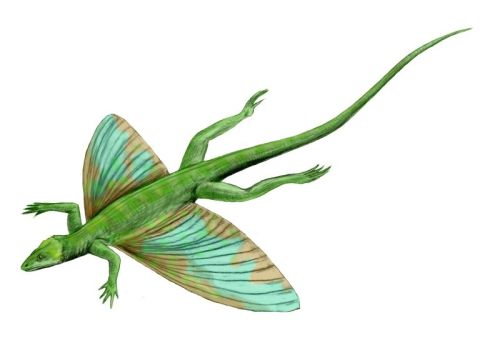
| Palaeos |  |
Diapsida |
| Vertebrates | Weigeltisauridae |
| Page Back | Unit Home | Unit Dendrogram | Unit References | Taxon Index | Page Next |
| Unit Back | Vertebrates Home | Vertebrate Dendrograms | Vertebrate References | Glossary | Unit Next |
|
Abbreviated Dendrogram
AMNIOTA |--SYNAPSIDA `--SAUROPSIDA |--ANAPSIDA `==EUREPTILIA | `--DIAPSIDA |==Araeoscelida `--Neodiapsida |=="Younginiformes" `--+--Claudiosaurus `--+--Coelurosauravidae `--+--+--Thalattosauria | `--ICHTHYOSAURIA |?--Omphalosaurus |?--Saurosphargidae |?--Hupehsuchia `--Sauria |?--CHORISTODERA |--LEPIDOSAUROMORPHA `--ARCHOSAUROMORPHA |
Contents
Overview |
 Coelurosauravus jaekeli, a gliding reptile from the Late Permian of Germany. illustration by Nobu Tamura (Wikipedia) |
Weigeltisauridae: Coelurosauravus, Rautiania, Weigeltisaurus arboreal gliding forms.
Synonyms: Coelurosauravidae.
Range: Late Permian of Europe, Madagascar, Russia and Canada
Phylogeny: Neodiapsida:: (Younginiformes + (Ichthyopterygia + Sauria)) + *.
Characters: Coelurosauravis: elongate, horizontal ribs – gliding membrane like Draco? Sues (1997) says not ribs: different support for gliding membrane. Loss of lower temporal bar, elaborate squamosal frill. Megalancosaurus had (1) osteological correlates for the existence of a birdlike prepatagial membrane; (2) elbow joints that, similar to many birds, "locked" at about 165 degrees extension (i.e., about 25 degree short of full extension); (3) fusion of dorsal vertebrae into a somewhat birdlike/pterosaur-like notarium; (4) lightened, externally "hollowed-out" long bones; (5) extremely long forelimbs, and possibly other flight or gliding adaptations. (Ruben, J. (2000) pers. comm on dinosaur listserver 4/6/00).
Links: UCMP - Basal Diapsids (only a paragraph), Wikipedia (stubby), link; link
Comments: very primitive forms with protorothyridid like characteristics in limb proportions and number of presacral vertebrae Currie, 1981 p.162, very basal relative to, and not closely related to, younginiformes (Currie, ibid, Benton 1985) though Bickelmann et al. 2009 gve them the opposite placement, not primitive than, but more advanced than younginiformes. This difference is certainly due to different cladistic methodologies (computer-statistical, supermatrixes and so on) used now, in contrast to the hand-drawn approach of the 1980s. One needs to ask whether the statistical approach using parsimony analysis of hundreds of trees, and with large numbers of atomistically distinct traits, better reveals or conceals phylogenetic relationships, in comparison to the approach used by early workers in the field.
Coelurosauravus elivensis Piveteau 1926
Synonyms: Daedalosaurus magagascariensis Carroll 1978 cospesific or distinct species?
Range: Late Permian of England and possibly Madagascar
Phylogeny: Weigeltisauridae : + *.
Coelurosauravus jaekeli (Weigelt 1930)
Synonyms: Palaeochamaeleo jaekeli Weigelt 1930; Gracilisaurus ottoi Weigelt 1930; Weigeltisaurus jaekeli (Weigelt 1930) Kuhn 1939] - ref Mikko's Phylogeny Archive
Range: Late Permian of West Germany
Phylogeny: Weigeltisauridae : + *.
| Page Back | Unit Home | Page Top | Page Next |
checked ATW050512
Using this material. All material by ATW is public domain and may be freely used in any way (also any material jointly written by ATW and MAK). All material by MAK is licensed Creative Commons Attribution License Version 3.0, and may be freely used provided acknowedgement is given. All Wikipedia material is either Gnu Open Source or Creative Commons (see original Wikipedia page for details). Other graphics are copyright their respective owners